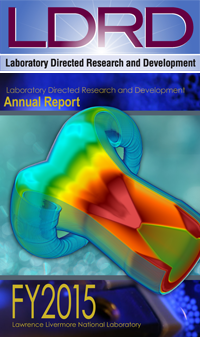Science and technology for our national security mission
Science and Technology on a Mission
A foreword from the Laboratory’s director.
Overview
A broad description of the LDRD Program, highlights of accomplishments and awards for the year, program statistics, and the LDRD portfolio-management process.
Advanced Materials and Manufacturing
Meeting national needs for the rapid, cost-effective development of advanced materials and manufacturing processes and systems including innovative new materials and synthesis and characterization methods.
Bioscience and Bioengineering
Working at the interface of biology, engineering, and the physical sciences to address national challenges in biosecurity, chemical security, bioenergy, and human health.
Chemical and Biological Security
Developing innovative systems and capabilities to rapidly detect and effectively respond to intentional use of chemical agents, pathogens, or natural outbreaks of pandemic diseases.
Cyber Security, Space, and Intelligence
Providing national security in a highly networked world through situational awareness and predictive analysis of the behavior of complex systems through investments in developing sensors, information systems, and analytics.
Energy and Climate Security
Delivering transformational solutions for national energy security, a re-invented energy grid, improved understanding of climate, and better adaptation to climate change.
High-Energy-Density Science
Providing international leadership in studying the properties of matter under extreme conditions of temperature and pressure including plasma physics, equations of state, and radiation transport.
High-Performance Computing, Simulation, and Data Science
Providing expertise and capabilities in the technically challenging drive toward exascale-class computing at a quadrillion calculations per second for mission-directed programs.
Inertial Fusion Science and Technology
Advancing fusion-related science and technology to meet a broad suite of national security needs and exploring the underlying science, technology, and engineering challenges for sustainable, intrinsically safe, carbon-free energy.
Lasers and Optical Science and Technology
Designing, building, and reliably operating complex laser systems that dramatically advance the state of the art to meet important needs for defense, energy, and industry.
Nuclear, Chemical, and Isotopic Science and Technology
Providing a unique resource for chemical and isotopic analysis of samples in support of wide-ranging research in chemical threat analysis, nuclear forensics, nuclear threat reduction, stockpile stewardship, and fundamental science.
Stockpile Stewardship Science
Providing high confidence in the safety, security, reliability, and effectiveness of the U.S. nuclear weapons stockpile that forms the foundation of annual assessments of stockpiled weapons and their certification.
About the Cover
Simulation of a hydrodynamic instability computed with the BLAST high-order finite-element code using the Vulcan supercomputer at Lawrence Livermore. This problem tests the ability of a code to propagate shock waves over multiple-material regions and handle complex mesh vortex-induced motion. The high-order algorithms enable resolving the physics at much higher fidelity and efficiency than is possible with traditional second-order algorithms. The shape arises from the fact that the shock travels faster in lower-density regions, resulting in natural vortex motion at the point where three shock waves meet. Work was supported by the LDRD project “Scalable High-Order Computational Multiphysics at Extreme Scale” (14-SI-002).






